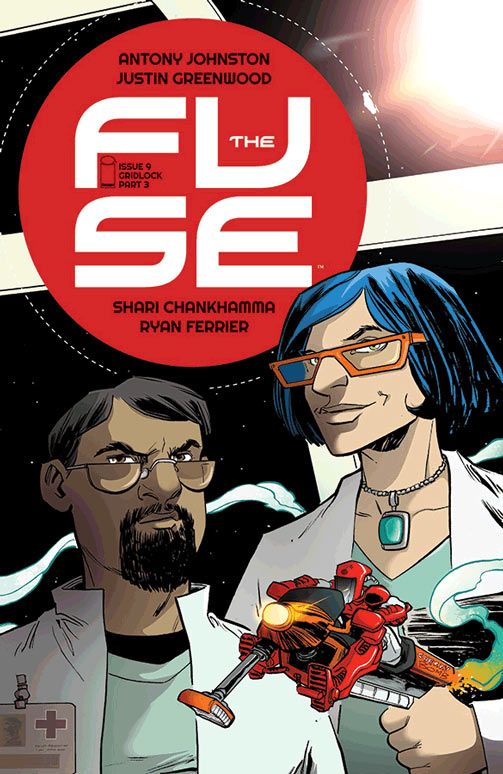The "Gridlock" storyline gets even thornier in "The Fuse" #9. Antony Johnston broadens and complicates the mystery of Cathy Kuang's murder, deepening the reader's knowledge of Midway City at the same time. Klem and Dietrich's latest case gets more twisted by the issue, and I love the way the world building is integrated into the problem at hand. With this complicated plot and wonderful world-building, "The Fuse" keeps getting better and better.
One of my criticisms of the first arc was that it didn't have a real sense of place yet, that Midway City didn't feel distinct outside of its science fiction trappings. However, this second arc nests the reader right inside the city. Johnston dives into the weird, wily corners of Midway City -- radical politics, illegal sports, drug trades - and, more importantly, emphasizes the ways they're all linked. In addition to the inherent drama of solving a murder, this world building is deeply satisfying as a simple fictional exercise. "The Fuse" feels more like a portrait of the city than just another procedural.
It also helps that Johnston has so many characters in play. The multiple suspects, police department employees and bureaucrats involved in this murder all have their own agendas, making Klem and Dietrich's work feel like a cog in a larger system. The characters' voices are distinct enough, though Johnston has a keen sense of when he's given the reader too much to remember - he's not above giving the audience clear reminders of who's who and he manages to do so without being condescending. It's easy to lose track of a cast this size, but Johnston handles it well.
Much as I like the crowd, there is a whole lot of talking in this issue. Justin Greenwood does a phenomenal job of covering up the amount of spoken exposition here. He varies perspective constantly, so that even when Klem and Dietrich don't leave an interrogation room, it feels as if the scene is moving. When he's given a particularly cool or science-fiction-heavy setting, he takes advantage of the interesting visual elements. All told, Greenwood saves the script from its own wordiness and Klem's facial expressions continue to entertain.
Colorist Shari Chankhamma keeps up the same greyer, realistic palette that she's used thus far. The scenes feel grittier and more realistic but not dull or dreary. Chankhamma isn't afraid to make scenes moody but she always remembers to keep them lively. I'd love to see her show a few more fireworks, just so the reader can enjoy it, but she's relentlessly effective so far.
Original letterer Ed Brisson also deserves kudos for his well-chosen fonts. The futuristic, contained font that he uses to indicate location names, per Johnston's design, strikes a fine balance between science fiction and Swedish design. Alongside the knotty little script he uses for dialogue, it reflects "The Fuse's" vision of lived-in science fiction. I also find that sci-fi comics are the most prone to ridiculous, unreadable fonts, so I appreciate Brisson's restraint.
In sum, the second arc of "The Fuse" is top-notch science fiction. You should really pick this series up.

